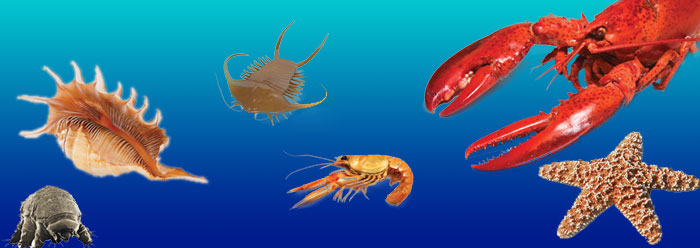In their 2010 zoology text, evolutionists Stephen Miller and John Harley present a clear summary of the current state of animal classification. They maintain, “There is little disagreement among zoologists about the taxonomic classification of animals”1, p. 156 Creation biologists agree. We’re hardly opposed to “the taxonomic classification of animals” and find such grouping and ordering extremely helpful as we study God’s creation. We would hasten to add that the modern era of taxonomy was introduced by Swedish botanist and creationist Carl Linnaeus (1707-1778), who gave us the Linnaean system of naming plant and animal species.
Miller and Harley go on to say exactly what creationists have been pointing out ever since Darwin: “Great disagreement exists, however, about how the animal phyla are related to one another.”1, p. 156 The reason for this ongoing “great disagreement” is that the animal phyla are not related to one another in any Darwinian sense! In other words, what we see in the fossil record is great discontinuity among plant and animal groups—as predicted by the creation model—rather than the continuity evolution assumes.
Not only is there a healthy disparity among the proposed evolutionary interrelationships of animal groups, but common ancestors, the missing links, are still unknown over 150 years after the publication of Darwin’s infamous book.
Occasionally, evolutionists protest that it would be extremely rare to find any soft-bodied creatures that would link groups together. But in recent years, more soft tissues in fossils are being unearthed.2 Impressions of soft tissues in sedimentary rock continue to be discovered and indicate that 1) soft tissue can be fossilized,3 2) the process of fossilization must be quite rapid (as in a flood!), and 3) these creatures have always been the same throughout supposed “geologic history” (with the possibility of extinction).
This article will address some of the more popular invertebrates (animals without backbones). Sometimes beautiful, sometimes deadly, they are creatures designed with exceeding complexity. They appear in sedimentary rocks complete and fully formed, and there is no sign that they have evolved from ancient ancestors.
Phylum Arthropoda
Arthropods—insects, spiders, and crustaceans—are members of the largest animal phylum, the Arthropoda. These creatures make up almost 85 percent of living animals and represent the majority of the fossil record.4, p. 168 God designed arthropods with jointed, paired appendages and an external skeleton (exoskeleton) composed of a unique compound called chitin. No evolutionist would expect chitin to survive in “primordial” fossils due to its chemical degradation, and yet “evidence of vestigial chitin” was recently found in a fossil scorpion and a fossil eurypterid.5 This is hardly amazing if these sediments, supposedly deposited “millions of years ago,” were actually laid down by the Genesis Flood 4,500 or so years ago.
Evolutionists dismiss creation and maintain that arthropods evolved from a non-arthropod ancestor sometime before the Cambrian period in the distant past. But because arthropods were created as arthropods just thousands of years ago, the evolutionary community must resort to “a highly speculative interpretation of arthropod phylogeny [evolution].”1, p. 268 In 2009, evolutionists Larry Roberts and John Janovy wrote:
As might be expected from arthropods’ long evolutionary history and extreme diversity, establishment of evolutionary relationships, especially among the more inclusive taxa, is a challenge that has occupied many scientists ever since Darwin’s time.6, p. 529
The “arthropod phylogeny problem” continues unabated. Gonzalo Giribet and Gregory Edgecombe state, “The exact sister group relationship of arthropods is, however, still debated.”4, p. 171 A current biology textbook acknowledges that “arthropod evolution and classification are controversial.”7, p. 662
The authors of another textbook state only that arthropods “may have evolved” from an extinct group called the lobopods.8, p. 684 God designed the Lobopodian as a complex multicellular animal with bilateral symmetry, a gut, and coordinated legs. There is no indication that anything evolved from it. A fossil Lobopodian displays no evolution for the supposed “200 million years” of its existence, and four evolutionists recently wrote, “The morphology has not changed in any significant aspect.”9 If the tardigrades (the water bear addressed below) and velvet worms of today are allegedly counterparts of Lobopodia, then where is the evidence of evolution? There has been no change from the lower Cambrian onward.
Darwinists have put increasing faith in novel molecular approaches and techniques to answer the vexing problem of arthropod origin and evolution. But such research often exposes as many mysteries as it supposedly solves, not only with the arthropods, but throughout the living world.
Here are just a few representative arthropods God has created.
Phylum Tardigrada
The plump, short water bear (tardigrade) looks positively amusing with its four pairs of stubby legs attached to a cylindrical body. These segmented, water-dwelling animals are less than a millimeter long and are often found lumbering on moist mosses and lichens. The hundreds of species of tardigrades were designed by the Creator to undergo a fascinating process called cryptobiosis (suspended animation), extending their lifespan up to 65 years.
Where did the water bear come from? In their zoology text, Cleveland Hickman and his fellow authors are diffident, stating, “Evolutionary relationships among ecdysozoans [e.g., Phylum Tadigrada and Arthropoda] are not well understood.”10, p. 402 Claus Nielsen states that Tardigrada “relationships to other groups has been debated.”11, p. 267 It would seem that tardigrades have always been tardigrades, with “fossils from the Middle Cambrian [that] strongly resemble living tardigrades.”11, p. 265 As predicted by creation scientists, there is nothing simple regarding these curious creatures. Nielsen writes that they are “complicated,” “complex,” and have “extraordinary abilities.”11, p. 265
Trilobites
The strange trilobite (so-named because its oval body is divided into three regions) is the creationist’s friend, undergoing variation in size and pygidial rib number but stubbornly refusing to evolve into anything else. Complex from the start, these creatures had amazing visual capabilities.12
There are at least 56 families of trilobites composed of about 3,900 species, “about 70% of the known Cambrian species of metazoans.”13, p. 278 Their size normally ranges from one to four inches, but some fossils are as much as 39 inches long. But small or large, they suddenly appear as 100 percent trilobites with no indication of gradual evolution. Evolutionists had hoped a fossil creature called Parvancorina found in the Ediacaran (the topmost portion of the Precambrian) would be the much-sought-after missing link to the trilobite. This turned out not to be the case, as the growth form of Parvancorina is uncommon for an arthropod14 and its seeming way of life points away from an arthropodan affinity.15
Is there an indication of how these hearty invertebrates became extinct? Fossil evidence points to a water-borne disaster. In 2011, a University of Cincinnati news release described mass kills of trilobites in such widespread locations as Oklahoma, Morocco, and Poland: “A smothering death by tons of hurricane-generated storm sediment was so rapid that the trilobites are preserved in life position.”16 A catastrophic flood such as Genesis describes would seem to be a reasonable agent.
Crustaceans
The crustaceans include the delicious shrimp, crab, and lobster. What is the origin of these succulent arthropods? The first fossil representatives found in Cambrian rocks (such as the abundant Marrella of the Burgess Shale) are 100 percent crustacean, with no indication they evolved from a non-crustacean ancestor—although evolutionists claim that the “modern crustacean lineages probably arose at various times. ”1, p. 268
What scientists find today are crustaceans of enormous complexity. Consider the shrimp:
The eye of the peacock mantis shrimp has led an international team of researchers to develop a two-part waveplate that could improve CD, DVD, blu-ray and holographic technology, creating even higher definition and larger storage density. Peacock mantis shrimp are one of only a few animal species that can see circularly polarized light—like the light used to create 3-D movies. Some researchers believe the mantis shrimp’s eyes are better over the entire visual spectrum than any artificial waveplates.17
A waveplate—or retarder plate—is a transparent optical unit that changes or manipulates the polarization state of a light beam travelling through it. It hardly seems likely that such amazing visual ability could be the result of chance, time, and natural processes. Instead, it shows purpose, plan, and special creation (Romans 1:20).
The following invertebrates also display remarkable evidence of the Creator’s design.
Phylum Platyhelminthes
The Platyhelminthes, or flatworms, are soft, unsegmented animals and include some of the most beautiful invertebrates in the world—the turbellarians. Snorkelers and divers delight in watching the lazy, colorful undulations of the three-inch divided flatworm (Pseudoceros) that lives in coral reefs.
Flatworms are anything but simple, and they do amazing things. For example, fission is a type of asexual reproduction undertaken by some planarians. The worm constricts in the middle, separating into a tail end and a head end, and then each end regenerates the missing parts (epimorphic regeneration). Zoologists find this ability extraordinary.
There are also the flukes (trematodes), one of which causes the devastating parasitic disease known as schistosomiasis. People become infected with this blood fluke when they wade or swim in fresh water containing a certain species of snail that serves as the intermediate host of this parasite. The tiny infective stage (cercaria) leaves the snail and actively swims to the vertebrate host—a human. It penetrates the skin by way of a hair follicle and then enters the bloodstream, where male and female worms develop and attach to the inside of the person’s circulatory system. The large numbers of eggs produced by the female and the host’s potent immune response cause this pathological condition.
Zoologists appreciate the enormous complexity of this parasite, beginning with the tiny cercaria that can rapidly alter its metabolism. It moves from the snail’s body, a complex internal milieu, and enters cold fresh water. From the water, it enters a much warmer environment (the human bloodstream) with a higher concentration of sodium and a sophisticated immune system with which it must successfully contend. In each of these new environments, biochemical changes to its physiology must be made within seconds!
Other flatworms include the dog and pork tapeworms—both potentially fatal to the human—and the more benign fish tapeworm. Each has a unique life cycle.
For decades, evolutionists thought these flatworms were only a primitive stage of bilaterians (animals with distinct back and front ends). But Hickman and his colleagues state, “Features of the most recent common ancestor of all bilaterian animals have been much debated,”10, p. 307 and can only suggest what the alleged ancestor of the flatworms may have been:
This ancestral form would have had a simple body with a blind gut, perhaps much like the body of an acoelomorph flatworm.10, p.308
Michael Allaby adds, “The phylum lacks a definite fossil record,”18, p. 492 and Neilsen states, “The fossil records are dubious.”11, p. 166
But if God looked at His finished creation and said it was good, from where did these parasitic worms come? Like evolutionists, creation scientists must offer a theoretical explanation regarding parasite origin. We suggest that before the Fall, these parasitic animals were nonthreatening, in keeping with God’s very good creation. They were what is termed free-living (non-parasitic) in the environment and had a full complement of body systems. Then, after the Fall, God cursed the earth and they became parasitic—dependent upon a host for survival. Support for this idea comes from an unlikely source: the evolutionary community. Various authors state that “parasitic species have retained some morphological resemblance with their free-living counterparts,”19, p.13 and “in fact, free-living species could become parasitic without substantial anatomical or physiological changes.”1, p. 226
Parasitologists Roberts and Janovy state, “The tiny worms in suborder Tylenchina appear to bridge a gap between free-living and parasitic modes of life, because several species alternate between free-living and parasitic generations.”6, p. 413 Or could God have adjusted the design of the flatworms and protozoa at the time of the Curse so that they now have organs specifically designed to allow them to feed off people and other creatures? He made an adjustment with thistles and thorns, causing pain. Perhaps parasites also fall into this category of design modification. Providing such potential explanations is one focus of research at the Institute for Creation Research.
Phylum Echinodermata
The beautiful sea stars (starfish) are one of the most easily identifiable marine invertebrates, with their characteristic radiating arms and stony skin of calcium carbonate. The sea star’s water vascular system is one of the more amazing arrangements in the animal world. Each of the five arms has a radial canal in a groove running down its length. In each of these canals are found hundreds of muscular, hollow, fluid-filled tube feet. The Creator designed these tiny tube feet with a foot (podium) and bulb (ampulla) attached to it. Adhesive chemicals secreted at the ends of the foot allow the animal to pull itself over the ocean floor or firmly attach to its favorite food, the clam. To disengage the foot, a specially designed organic solvent is secreted and the podium is hydraulically shortened. What is left behind is an adhesive signature “smudge.” The brittle stars and basket stars comprise the largest group of echinoderms.
What is the evolutionary origin of complex creatures such as the sea stars?
The evolutionary relationships among the echinoderms are not clear. Numerous fossils date into the Cambrian period, but no interpretation of the evolutionary relationships among living and extinct echinoderms is definitive.1, p. 281
Evolutionists can only speculate that echinoderms possibly evolved from an unknown bilaterally symmetrical ancestor sometime in the early Cambrian—or even the Precambrian in the case of Tribrachidium discovered in Australia. Miller and Harley state:
Most zoologists believe that echinoderms evolved from bilaterally symmetrical ancestors. Radial symmetry probably evolved during the transition from active to more sedentary lifestyles; however, the oldest echinoderm fossils, about 600 million years old, give little direct evidence of how this transition occurred.1, p. 281
But who were the bilaterian ancestors? The late Neil Campbell and his fellow authors state:
While the sequence of bilaterian evolution is a subject of active investigation, most researchers think that the most resent common ancestor of living bilaterians probably existed in the late Proterozoic eon (about 575 million years ago).8, p. 674
“Believe” and “probably” should not be associated with the alleged scientific fact of evolution. Hickman et al tell us, “Despite [echinoderm] fossil record, numerous contesting hypotheses on their [evolutionary relationships] have been proposed.”10, p. 492 James Valentine was succinct, stating, “Despite this easy identification of echinoderm skeletons, most of the nominal classes are rather distinctive, appear abruptly, and are separated from one another by morphological gaps at their first appearance.”12, p. 393 Recently, a core from the North Sea revealed fossils of echinoderms with an assigned date of “114 million years”—much earlier than previously supposed by evolutionists, but they were still plain old echinoderms.20
An interesting trend has been going on for decades, a development secular paleontologists would rather ignore (like soft dinosaur tissue). Every major animal body plan is found entombed in Cambrian sediments. (The main body axes are established in the early embryo.) The ongoing discoveries cause trouble for the secular paleontologist because each complex body plan is found earlier and earlier and shows no evolution. For example, with regard to the echinoderms, one study states, “Because many of these taxa appear close to the beginning of the middle Cambrian, it seems likely that their origins must be placed in the early Cambrian.”21 Evolutionists keep having to rework their evolutionary timelines, but such abrupt appearances of sophisticated body plans would be expected if they were created fully formed.
Phylum Annelida
A discussion of the invertebrates would not be complete without a nod to every biology student’s friend, the earthworm! Although it looks to be “just a worm,” it is, in fact, a highly intricate creature. Like the echinoderm, annelids have been created with sophisticated systems and structures. Creation scientist Gary Parker states:
Most people think of segmented worms as fish bait, but to a biologist, they are marvelously complex. The “lowly” earthworm, for example, has five “hearts,” a two-hemisphere brain, and a multi-organ digestive system.22
Evolutionist Allaby says, “Anatomically they are more complex than the Platyhelminthes. They have vascular, respiratory, and nervous systems which are well developed.”18, p. 33
The characteristic segments of the annelids are an enigma to Darwinists: “No truly satisfactory explanation has yet been given for the origins of segmentation and the coelom, although the subject has stimulated much speculation and debate.”10, 383 We have all watched the wriggling movements of the earthworm. God designed each segment with circular and longitudinal muscles designed to work against the hydrostatic (body cavity fluid held under pressure) skeleton.
Is there any evidence for their supposed evolution? “Annelid evolution is still poorly understood,” states Nielsen.11, p. 114 Valentine discusses “annelid ancestry” in his book, but it is speculative and hypothetical.12 Miller and Harley write, “Unfortunately, little evidence documents the evolutionary pathways that resulted in the first annelids.”1, p. 197
Truly, annelids have always been annelids, as shown by the fossil record. “Their fossils are found in rocks dating from the Cambrian, and possible fossil annelid worms are known from Precambrian sediments in southern Australia.”18, p. 33 The Ediacaran beds of South Australia contain jellyfish as well as annelids—but not their supposed ancestors. These Precambrian fossils powerfully support the creation model.
Summary
Looking at these popular invertebrates, we see they are amazingly sophisticated and, as predicted by creationists, complete wherever they are found in the fossil record.23 There is clearly variation within these separate groups, as in, for example, the large number of trilobite families. But these designed creatures remain within their basic kinds and display a discontinuity of both form and function.
Over 150 years have passed since the publication of Darwin’s Origin of Species, and yet the secular community of scientists is unable to provide a compelling evolutionary sequence for any of the various kinds of invertebrates. The missing links are still missing. As Paul tells us in Romans 1:20, our all-wise Creator designed our amazing invertebrates with a complexity that is “clearly seen.”
References
- Miller, S. and J. Harley. 2010. Zoology, 8th ed. New York: McGraw Hill Publishers, 156.
- Thomas, B. 2013. DNA in Dinosaur Bones? Acts & Facts. 42 (1): 15.
- Sherwin, F. 2005. PB & J (Painful Blisters and Jellies). Acts & Facts. 34 (10).
- Giribet, G. and G. D. Edgecombe. 2012. Reevaluating the Arthropod Tree of Life. Annual Review of Entomology. 57: 168.
- Cody, G. D. et al. 2011. Molecular Signature of Chitin-protein Complex in Paleozoic Arthropods. Geology. 39 (3): 255-258.
- Roberts, L. and J. Janovy. 2009. Foundations of Parasitology. New York: McGraw-Hill and Co., 529.
- Solomon, E., L. Berg and D. Martin. 2011. Biology, 9th ed. Belmont, CA: Brooks and Cole, 662.
- Campbell, N. et al 2008. Biology, 8th ed. Glenview, IL: Pearson Education, Inc., 684.
- Haug, J. T. et al. 2012. A Carboniferous Non-Onychophoran Lobopodian Reveals Long-term Survival of a Cambrian Morphotype. Current Biology. 22 (18): 1673-1675.
- Hickman, C. et al. 2011. Integrated Principles of Zoology, 15th ed. New York: McGraw Hill Publishers. 402.
- Nielsen, C. 2012. Animal Evolution: Interrelationships of the Living Phyla, 3rd ed. New York: Oxford University Press, 267.
- Sherwin, F. 2006. Un-Bee-lievable Vision. Acts & Facts. 35 (2).
- Valentine, J. W. 2004. On the Origin of Phyla. Chicago: University of Chicago Press, 278.
- Ivantsov, A. Y. and E. B. Naimark. 2007. Ontogenetic Variability in the Late Vendian Problematics Parvancorina Glaessner, 1958. The Rise and Fall of the Vendian (Ediacaran) Biota. Origin of the Modern Biosphere. Transactions of the International Conference on the IGCP Project 493. Moscow: GEOS, 13-18; Naimark, E. B. and A. Y. Ivantsov. 2009. Growth variability in the Late Vendian Problematics Parvancorina Glaessner. Paleontological Journal. 43 (1): 12-18.
- Paterson, J. 2010. International Palaeontology Congress. London, UK.
- Hand, G. Fossils Record Ancient Migrations & Trilobite Orgies. University of Cincinnati news release, March 17, 2011.
- Mantis Shrimp Eye Could Improve High-Definition CDs, DVDs. Penn State news release, June 24, 2011.
- Allaby, M. 2009. Oxford Dictionary of Zoology. New York: Oxford University Press, 492.
- Poulin, R. 2007. Evolutionary Ecology of Parasites, 2nd ed. Princeton, NJ: Princeton University Press, 13.
- New Fossils Suggest Ancient Origins of Modern-Day Deep-Sea Animals. ScienceDaily. Posted on sciencedaily.com October 10, 2012, accessed November 25, 2012.
- Zamora, S. 2010. Middle Cambrian Echinoderms from North Spain Show Echinoderms Diversified Earlier in Gondwana. Geology. 38 (6): 507-510.
- Parker, G. 2006. Creation: Facts of Life. Green Forest, AR: Master Books, 159.
- Sherwin, F. 2011. "Relatively Simple." Acts & Facts. 40 (7): 17.
* Mr. Sherwin is Research Associate, Senior Lecturer, and Science Writer at the Institute for Creation Research.
Cite this article: Sherwin, F. 2013. God’s Amazing Invertebrates: The Missing Links Are Still Missing. Acts & Facts. 42 (2): 12-15.






















